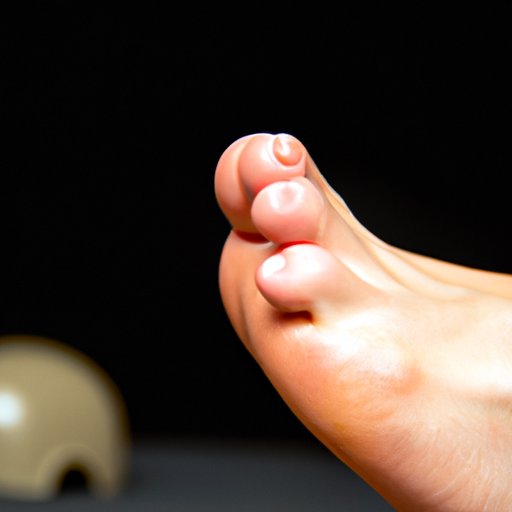
I. Introduction
If you suffer from a painful and unsightly bunion, you’re not alone. Bunions are a common foot problem caused by an enlargement of the joint at the base of the big toe. They can be caused by genetics, improper footwear, or foot injuries. In this article, we will explore different options for getting rid of bunions, including home remedies, surgical options, proper footwear, massage therapy, exercises, and lifestyle changes.
II. Home Remedies for Bunions
There are several home remedies you can try to alleviate the pain and discomfort of a bunion:
Ice therapy: Apply ice to the affected area multiple times a day for 15-20 minutes at a time to reduce swelling and inflammation.
Foot stretches and exercises: Stretching and exercising your feet and toes can alleviate pressure on your bunion. Calf stretches, toe curls, and ankle rotations can be particularly helpful.
Over-the-counter pain relievers: Take nonsteroidal anti-inflammatory drugs (NSAIDs) like ibuprofen to reduce pain and inflammation.
Epsom salt baths: Soaking your feet in warm water with Epsom salt for 20-30 minutes can relieve pain and soreness.
Bunion pads and cushions: These products can help reduce pressure and rubbing on your bunion, making it more comfortable to walk or stand.
Shoe inserts and orthotics: These can help distribute pressure evenly on your feet, providing relief for your bunion.
III. Surgical Options for Bunions
If home remedies don’t provide relief, surgery may be necessary. There are several surgical options for bunions:
Bunionectomy: This is the traditional surgical removal of the bunion.
Osteotomy: This involves realigning the bones in your foot to correct the bunion.
Arthrodesis: This involves fusing the joint in your toe to alleviate pain and prevent the bunion from getting worse.
Each option has its own pros and cons, as well as different recovery times. Your doctor can help you determine which option is right for you based on the severity of your bunion and your overall health.
IV. Proper Footwear for Bunion Pain Relief
Wearing the right shoes can go a long way in relieving bunion pain. Here are some tips:
Importance of wearing the right shoes: Shoes that are too tight or have high heels can make your bunion worse. Look for shoes with a wide toe box and low heels.
Best shoe brands for bunion sufferers: Some shoe brands are better than others for bunion pain relief. Look for brands like New Balance, Brooks, and ASICS.
Features to look for in shoes: Look for shoes with good arch support, a cushioned sole, and a breathable upper.
Importance of shoe inserts and orthotics: Inserts and orthotics can add extra cushioning and support to your shoes, reducing pressure on your bunion.
How often to wear them: Wear shoes with proper inserts or orthotics as often as possible, including when you’re walking around the house or running errands.
V. Massage Therapy for Bunions
Massage therapy can be another way to relieve bunion pain. Here are some options:
Different types of massage techniques: Massage therapists may use Swedish massage, deep tissue massage, or trigger point therapy to alleviate pain and tension in the foot.
Self-massage tips: You can also try massaging your own feet and toes by using a tennis ball or golf ball to roll under your foot.
Professional massage options: If your bunion pain is severe, you may benefit from seeing a professional massage therapist who can provide more targeted relief.
When to see a professional: Talk to your doctor about whether massage therapy is a good option for you and if they can recommend a licensed massage therapist.
VI. Toe and Foot Exercises for Bunion Pain Relief
Toe and foot exercises can help strengthen and stretch the muscles in your feet and alleviate pressure on your bunion. Here are some exercises to try:
Toe curls: Curl your toes as tightly as you can and hold for five seconds, then release. Repeat 10 times on each foot.
Resistance band exercises: Use a resistance band to stretch and strengthen your feet and toes. Place the band around your foot and flex and point your toes against the resistance.
Ankle flexion and extension: Sit in a chair with your feet flat on the floor. Flex your ankle up and hold for five seconds, then release. Repeat 10 times on each foot.
Yoga poses for feet and toes: Yoga can help alleviate pain and improve flexibility in your feet. Try poses like downward dog, child’s pose, and eagle pose.
Stretching exercises: Stretching your calf muscles can also help alleviate pressure on your bunion. Place your hands on a wall and step one foot back, pressing your heel into the ground. Hold for 30 seconds and repeat on each foot.
VII. Lifestyle Changes for Bunion Pain Relief
In addition to home remedies and medical treatments, there are several lifestyle changes you can make to alleviate bunion pain:
Losing weight: Excess weight puts extra pressure on your feet, which can make your bunion worse. Losing weight can help reduce the pressure and alleviate pain.
Avoiding high heels or tight shoes: High heels and tight shoes can exacerbate bunion pain. Opt for low-heeled shoes with a wide toe box instead.
Reducing the amount of time sitting or standing: Extended periods of sitting or standing can put pressure on your feet. Take frequent breaks to stretch and move around.
Strengthening foot and toe muscles: Regular exercise and stretching can help strengthen your foot and toe muscles, reducing pain and preventing future bunions.
Wearing proper footwear: Wearing shoes with a wide toe box, low heels, and proper inserts or orthotics can make a huge difference in relieving bunion pain.
VIII. Conclusion
Bunions can be a painful and frustrating foot condition, but they don’t have to be a permanent problem. By making lifestyle changes, wearing proper footwear, trying home remedies, and seeking medical treatment if necessary, you can alleviate bunion pain and get back to your daily routine.





